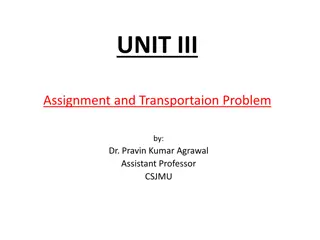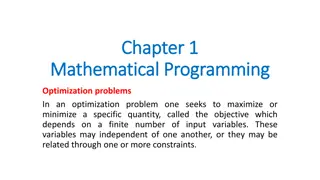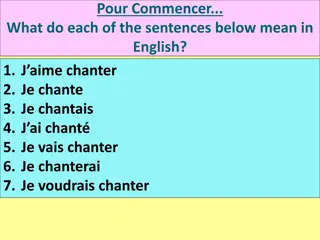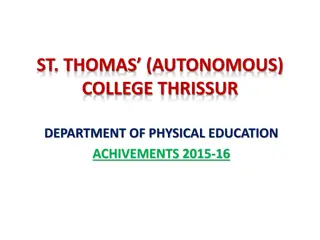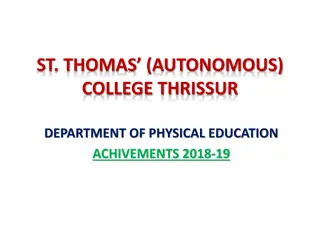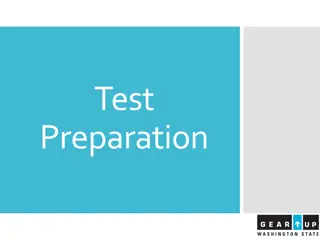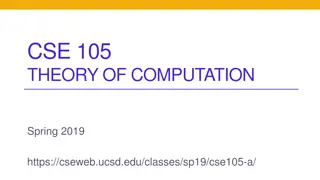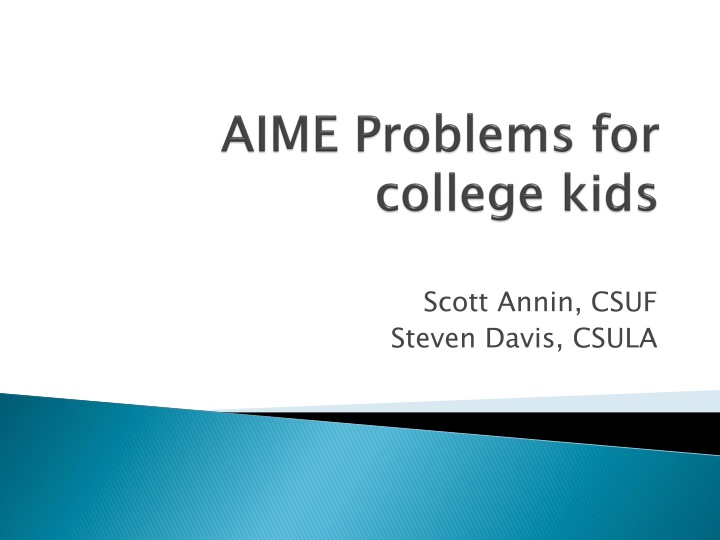
Solving Diophantine Equations with Base Conversions
Explore the solutions to Diophantine Equations involving base conversions and find the base 10 representation of a number written in different bases. Discover the best approach among the three methods provided to tackle the problem efficiently.
Download Presentation

Please find below an Image/Link to download the presentation.
The content on the website is provided AS IS for your information and personal use only. It may not be sold, licensed, or shared on other websites without obtaining consent from the author. If you encounter any issues during the download, it is possible that the publisher has removed the file from their server.
You are allowed to download the files provided on this website for personal or commercial use, subject to the condition that they are used lawfully. All files are the property of their respective owners.
The content on the website is provided AS IS for your information and personal use only. It may not be sold, licensed, or shared on other websites without obtaining consent from the author.
E N D
Presentation Transcript
Scott Annin, CSUF Steven Davis, CSULA
Find the sum of all the roots, real and non- real, of the equation x2001+ ( - x)2001= 0, given that there are no multiple roots.
How many roots does this polynomial have? How many roots does this polynomial have? [Fundamental Theorem of Algebra] A polynomial of degree n has exactly n roots, including multiplicities, real, and complex roots. [Fundamental Theorem of Algebra] What is the degree of this polynomial? What is the degree of this polynomial?
How many roots does this polynomial have? How many roots does this polynomial have? [Fundamental Theorem of Algebra] A polynomial of degree n has exactly n roots, including multiplicities, real, and complex roots. [Fundamental Theorem of Algebra] What is the degree of this polynomial? Answer: 2000. That s a lot of roots! What is the degree of this polynomial?
How many roots does this polynomial have? How many roots does this polynomial have? [Fundamental Theorem of Algebra] A polynomial of degree n has exactly n roots, including multiplicities, real, and complex roots. [Fundamental Theorem of Algebra] What is the degree of this polynomial? Answer: 2000. That s a lot of roots! What is the degree of this polynomial? Key Idea: Group the roots in pairs that sum to . There are 1000 pairs, so the sum is 500. Key Idea: If r is a root, then so is - r.
The number n can be written in base 14 as a b c, can be written in base 15 as a c b, and can be written in base 6 as a c a c, where a > 0. Find the base 10 representation of n.
This problem can be solved in one of three ways. Each way involves a Diophantine Equation that may be easier or harder to solve than another equation. Which of these three ways is best? abc14= acb15 abc14= acac6 acb15= acac6
acb15 = acac6 225a + 15c +b = 216a + 36c +6a +c from which it follows 3a + b = 22c. Immediately c has to be 1. If a = 3 and b = 13 then 225a + 15c +b =703, 216a + 36c +6a +c = 703, but 196a + 14b + c =771. If a = 4 and b = 10 then 225a + 15c +b =925, 216a + 36c +6a +c = 925, and 196a +14b + c =925. So the answer is 925.
Define a regular n-pointed star to be the union of n line segments P1P2, P2P3,..., PnP1 such that the points P1, P2,...,Pn are coplanar and no three of them are collinear, each of the n line segments intersects at least one of the other line segments at a point other than an endpoint, all of the angles at P1, P2,...,Pn are congruent, all of the n line segments P1P2, P2P3,..., PnP1 are congruent, and the path P1P2 ...PnP1 turns counterclockwise at an angle of less than 180 at each vertex.
Understand the Problem Devise a plan Carry out the plan Check and Review
There are no regular 3-pointed, 4-pointed, or 6-pointed stars. All regular 5- pointed stars are similar, but there are two non-similar regular 7-pointed stars. How many non-similar regular 1000- pointed stars are there?
n = 7 n = 7 n = 5 n = 5 n = 6 n = 6 n = 9 n = 9 n = 9 n = 9 n = 8 n = 8 n = 9 n = 9 n = 9 n = 9 n = 8 n = 8
Pairs of j values producing stars Pairs of j values producing stars Number of n n- -pointed stars Number of pointed stars n n 2 2 3 3 4 4 5 5 6 6 7 7 8 8 9 9 10 10 11 11 12 12
Pairs of j values producing stars N/A Pairs of j values producing stars Number of n n- -pointed stars 0 Number of pointed stars n n 2 2 N/A 0 3 3 N/A 0 4 4 (2,3) 1 5 5 N/A 0 6 6 (2,5) and (3,4) 2 7 7 (3,5) 1 8 8 (2,7) and (4,5) 2 9 9 (3,7) 1 10 10 (2,9) and (3,8) and (4,7) and (5,6) (5,7) 4 11 11 1 12 12
Let N N = 100 + 32 2 2 22 2 1 12 2, , = 1002 2 + 99 + 992 2 98 982 2 97 972 2 + 96 + 962 2+ + 4 + + 42 2 + 3 where the additions and subtractions alternate in pairs. Find the remainder when N is divided by 1000. How to best attack this problem?
This is the easiest way; we rewrite it as such: N = 1002 + (992 982) (972 962) + (952 942) + (32 22) 12 = 1002 + (99 98)(99+98) (97 96)(97 + 96) + (95 94)(95 + 94) + (3 2)(3 + 2) 12 = 1002 + (99 + 98 97 96) + (95 + 94 93 92) + + (3 + 2 1 0) = 1002 + 4*25 = 1002 + 100 = 10100 ANSWER: 100
Let (a1, a2, a3, . . . , a12) be a permutation of (1, 2, 3, . . . , 12) for which a1 > a2 > a3 > a4 > a5 > a6 and a6 < a7 < a8 < a9 < a10 < a11 < a12. An example of such a permutation is (6, 5, 4, 3, 2, 1, 7, 8, 9, 10, 11, 12). Find the number of such permutations.
From a1 > a2 > a3 > a4 > a5 > a6 < a7 < a8 < a9 < a10 < a11 < a12 , Do we know specifically any of the values?
From a1 > a2 > a3 > a4 > a5 > a6 < a7 < a8 < a9 < a10 < a11 < a12 , Do we know specifically any of the values? YES: a6 =1.
From a1 > a2 > a3 > a4 > a5 > a6 < a7 < a8 < a9 < a10 < a11 < a12 , Do we know specifically any of the values? YES: a6 =1. From the remaining 11 numbers, choose 5 of them to be assigned to a1, a2, a3, a4, a5. The remaining numbers are then forced to be assigned a7, a8, a9, a10, a11 , a12.
From a1 > a2 > a3 > a4 > a5 > a6 < a7 < a8 < a9 < a10 < a11 < a12 , Do we know specifically any of the values? YES: a6 =1. From the remaining 11 numbers, choose 5 of them to be assigned to a1, a2, a3, a4, a5. The remaining numbers are then forced to be assigned a7, a8, a9, a10, a11 , a12. ANSWER: C(11,5) = 462. ANSWER: C(11,5) = 462.
The degree measures of the angels in a convex 18-sided polygon form an increasing arithmetic sequence with integer values. Find the degree measure of the smallest angle. This problem can be solved using formulas for an arithmetic sequence and noting the series sums to 16*180=2880, but that leaves us with one equation and two unknowns. What s the fastest way to solve it?
A right circular cone has base radius r and height h. The cone lies on its side on a flat table. As the cone rolls on the surface of the table without slipping, the point where the cone s base meets the table traces a circular arc centered at the point where the vertex touches the table. The cone first returns to its original position on the table after making 17 complete rotations. The value of h/r can be written in the form m n, where m and n are positive integers and n is not divisible by the square of any prime. Find m + n .
The Annual Interplanetary Mathematics Examination (AIME) is written by a committee of five Earthlings, five Martians, and five Venusians. At meetings, committee members sit at a round table with chairs numbered 1 to 15 in clockwise order. Committee rules state that a Martian must occupy chair 1 and an Earthling must occupy chair 15. Furthermore, no Earthling can sit immediately to the left of a Martian, no Martian can sit immediately to the left of a Venusian, and no Venusian can sit immediately to the left of an Earthling. The number of possible arrangements is N(5!)3. Find N.






